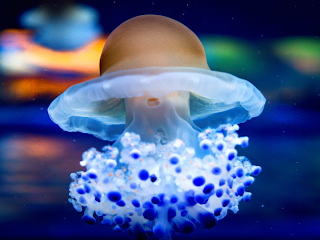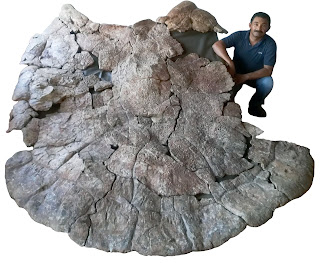Light in the oceans? It is chemistry, my friends.
In the inky blackness of the deep sea, more than 90% of the animals are luminescent. It is quite a startling number but makes good sense when you think of the edge bioluminescence provides.
The ability to generate light helps umpteen animals find mates, attract prey and avoid predation. Handy stuff, light.
What you know about light above the surface does not hold true for the light you see as bioluminescence. Its energy and luminosity come from a chemical reaction.
In a luminescent reaction, two types of chemicals — luciferin and luciferase — combine together. Together, they produce cold light — light that generates less than 20% thermal radiation or heat.
The light you see is produced by a compound called Luciferin. It is the shiny, showy bit in this chemical show. Luciferase acts as an enzyme, the substance that acts as a catalyst controlling the rate of chemical reactions, allowing the luciferin to release energy as it is oxidized. The colour of the light depends on the chemical structures of the chemicals. There are more than a dozen known chemical luminescent systems, meaning that bioluminescence evolved independently in different groups of organisms.
Coelenterazine is the type of luciferin we find in shrimp, fish and jellyfish. Dinoflagellates and krill share another class of unique luciferins, while ostracods or firefleas and some fish have a completely different luciferin.
The luciferase found in dinoflagellates is related to the green chemical chlorophyll found in plants. Bioluminescent dinoflagellates are a type of plankton — teensy marine organisms that make the seaways shimmer like the Milky Way as you swim through them.
Their twinkling lights are brief, each containing about 100 million photons that shine for a tenth of a second. While each individual flicker is here and gone in the wink of an eye, en masse they are awe-inspiring. I have spent many wondrous evenings scuba diving amongst these glittering denizens off our shores.
 |
| Cotylorhiza Tuberculata Jellyfish |
In this close up of a
Cotylorhiza Tuberculata Jellyfish, you can see the luminosity of her blue and white tentacles. The occurrence of identical luciferins for different types of organisms may suggest a dietary source for some groups strengthening the adage,
you are what you eat, or perhaps
you glow how you eat.
Bacteria and fireflies have unique luminescent chemistries. Fireflies light up when oxygen combines with calcium, adenosine triphosphate (ATP) and luciferin in the presence of luciferase.
For bacteria, the world stage of luminosity is quite small — and a bit gormless. Just how much light they emit and when is a free-for-all. Not so for the rest of our bioluminescent friends who have very precise control over when they shine and just how bright.
Bioluminescence comes in a variety of colours, from blue through red. The colour is based on the chemistry, which involves a substrate molecule called luciferin, the source of energy that goes into light, and an enzyme called luciferase or photoprotein.
Most of this lighting up of our world happens on land or in saltwater. There are almost no bioluminescent organisms native to freshwater.
In terrestrial plants and animals — fireflies, beetles and fungi like this Ghost Fungus,
Omphalotus nidiformis, a gilled basidiomycete mushroom — we commonly find green, yellow, and sometimes red.
In the ocean, bioluminescence is mostly blue-green or green. You would think that blues and green would not show up all that well in our seas but, surprisingly, they do. While sound travels better through saltwater than air, it is the reverse for light.
Various colours of light do not transmit equally through saltwater. Once we move deeper than the top layer of the ocean warmed by the sun and brimming with nutrients, the epipelagic zone, and move deeper through the mesopelagic, deeper and deeper still to the bathypelagic, frigid abyssalpelagic and finally the deep trenches of the icy pressure and all but inhospitable hadalpelagic, less and less light — until no light — gets through.
It is the twilight of the mesopelagic, 200 - 1000 metres below the surface, that is the sweet spot for most of our bioluminescent friends. Here, only very faint sunlight gets through. The water pressure is higher than at the surface but still lacks the crushing intensity of the lower zones. It is here that bioluminescence becomes a real advantage — good real estate and the showmanship of light pays gold.
We know that the deeper you go in our oceans, less and less sunlight gets through, so if the purpose of bioluminescence is to provide a signal that is noticed by prey, potential mates and predators alike, it is important that the light moves through the seawater, and not be absorbed or scattered — and this plays out in the colours evolved to be seen here.
If you have spent any time underwater, you will know that blue-green light transmits best through seawater. The deeper you go, the colours fade. Gone are the reds and yellows until everything looks brown or blue-green. Because of this, it is no surprise that blue-green is the most common colouring of bioluminescence in our oceans.
There are some exceptions to the blue-green/green colour rule — minuscule planktonic polychaete worms, Tomopteris helgolandica, emit yellow light, and deep-sea fish Malacosteus niger in the family Stomiidae, the barbeled dragonfishes, produce both red and blue.
Malacosteus niger's unique adaptation of producing red bioluminescence is only found in two other deep-sea dwelling creatures,
Aristostomias and
Pachystomias.
This rare form of bioluminescence can reach up to 700 nm in the deep-sea and cannot be perceived by green and blue bioluminescent organisms — granting M. niger a considerable advantage while hunting at depth.
The red light may function as an invisible searchlight of sorts because most animals in the ocean cannot see red light, while the eyes of M. niger are red-sensitive. It is much easier to find and eat something that cannot see you, particularly if it is lit up like a tasty red holiday snack.
Reference: https://latzlab.ucsd.edu/bioluminescence/







































